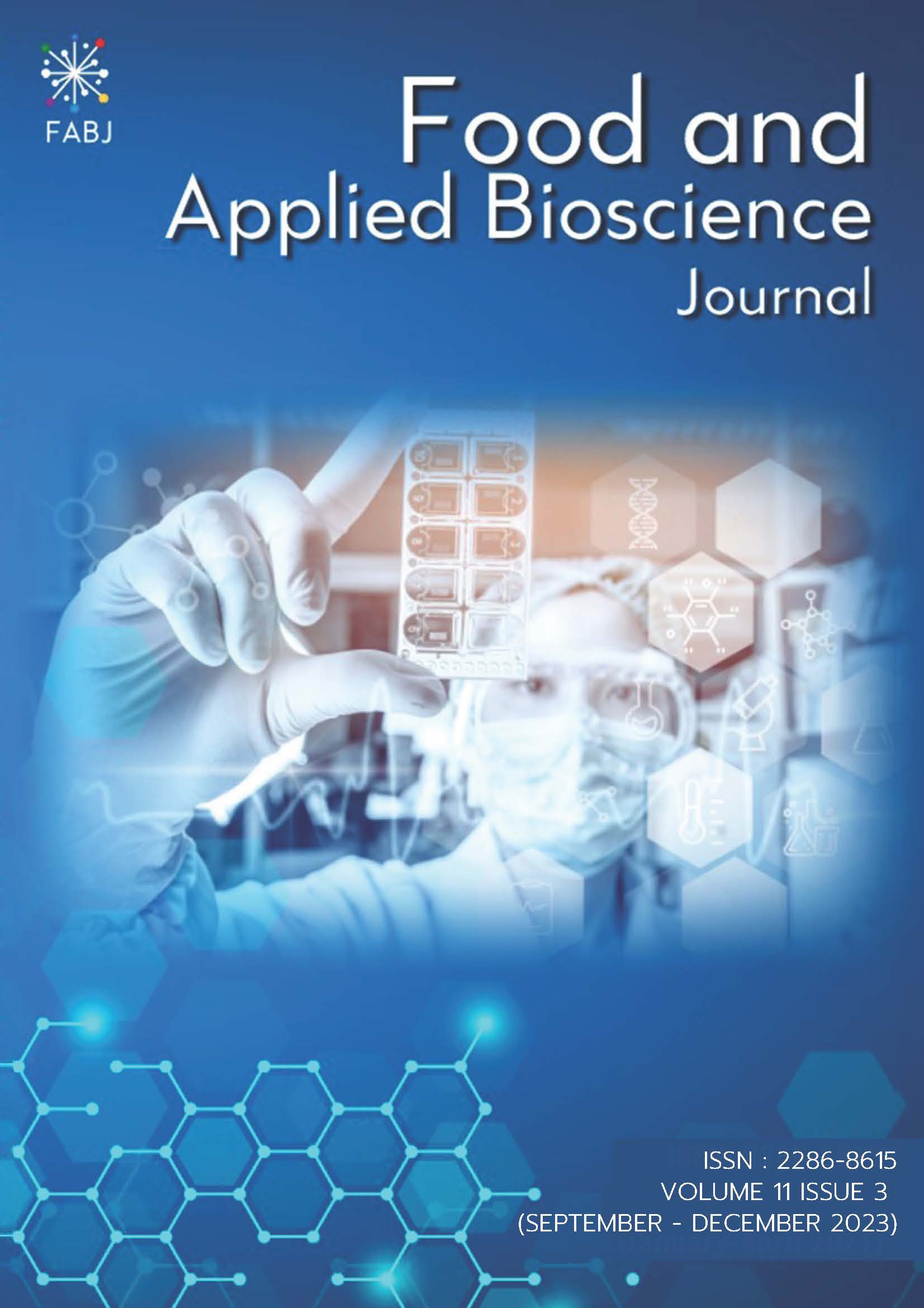A protein-enriched rice product from Kum Doi Saket rice, and locallysourced nutrient-rich grainsfrom Northern Thailand
Keywords:
Protein-enriched rice, Lablab purpureus L, Perilla frutescens L, Fortified rice grain, Antioxidant activityAbstract
Rice, recognized as a primary source of carbohydrates, is associated with
a high glycemic index, potentially elevating the risk of various diseases, including obesity and diabetes. This research aims to develop a fortified extruded rice product from the low-value broken grain Kam Doi Saket rice through the enrichment of protein and phenolic compounds by the addition of Lablab beans and perilla seeds. In the experiments, the proportion of Lablab bean powder was varied at ratios of 0%, 15%, 35%, and 55%, and the best formula from the initial experiments was used to adjust the quantity of perilla seeds at ratios of 0%, 1%, 3%, and 5%. Results revealed that an increase in the proportion of Lablab beans in the product led to increase protein content, increased levels of total phenolic compounds, and enhanced antioxidant capacities in the fortified rice product. In terms of texture, this formula exhibited the highest hardness values, while cohesiveness, adhesiveness, and chewiness values were comparatively lower than those of other formulas. Moreover, the outcomes of the perilla seed application indicated that the recipe employing Kam Doi Saket rice, Lablab beans, and perilla seeds in a ratio of 42:55:3 resulted in a protein content of 17.02%, total phenolic compounds measuring 0.44 mg GAE/g, an antioxidant capacity percentage of 0.19 mgTE/g, and an overall acceptance sensory score of 5.70.
In conclusion, it was determined from the experiments that Lablab beans and perilla seeds can serve as suitable raw materials for the production of protein-fortified rice products from broken Kam Doi Saket Rice.
References
AOAC. 2000. Association of Official Analytical Chemists Official Methods of Analysis 18th, AOAC, Washington, DC, USA, 2000.
Brand-Williams, W., Cuvelier, M.-E. and Berset, C. 1995. Use of a free radical method to evaluate antioxidant activity. LWT-Food science and Technology. 28: 25-30.
Dhyani, A., Chopra, R. and Garg, M. 2019. A review on nutritional value, functional properties and pharmacological application of perilla (Perilla frutescens L.). Biomedical and Pharmacology Journal. 12: 649-660.
Karladee, D., Gavilo, A. and Jamjod, S. 2012. Early generation selection for amylose content in rice grain: heritability and response to selection. Chiang Mai University Journal of Natural Sciences. 11: 87-96.
Kim, J.-S. and Chung, H.-Y. 2008. Characterization of volatile components in field bean (Dolichos lablab) obtained by simultaneous steam distillation and solvent extraction. Preventive Nutrition and Food Science. 13: 18-22.
Kongkeaw, S., Riebroy, S. and Chaijan, M. 2015. Comparative studies on chemical composition, phenolic compounds and antioxidant activities of brown and white perilla (Perilla frutescens) seeds. Chiang Mai Journal of Science. 42: 896-906.
Leslie, R. D., Ma, R. C. W., Franks, P. W., Nadeau, K. J., Pearson, E. R. and Redondo, M. J. 2023. Understanding diabetes heterogeneity: key steps towards precision medicine in diabetes. The Lancet Diabetes & Endocrinology. DOI: 10.1016/S2213-8587(23)00159-6.
Li, C., Ji, Y., Li, E. and Gilbert, R. G. 2023. Interactions between leached amylose and protein affect the stickiness of cooked white rice. Food Hydrocolloids. 135: 108215.
Maheshu, V., Priyadarsini, D. T. and Sasikumar, J. M. 2013. Effects of processing conditions on the stability of polyphenolic contents and antioxidant capacity of Dolichos lablab L. Journal of Food Science and Technology. 50: 731-738.
Sargi, S. C., Silva, B. C., Santos, H. M. C., Montanher, P. F., Boeing, J. S., Santos Júnior, O. O., Souza, N. E. and Vientainer J. V. 2013. Antioxidant capacity and chemical composition in seeds rich in omega-3: chia, flax, and perilla. Food Science and Technology. 33: 541-548.
Singleton, V. L., Orthofer, R. and Lamuela-Raventós, R. M. 1999. Analysis of total phenols and other oxidation substrates and antioxidants by means of folin-ciocalteu reagent. Methods in Enzymology. 299: 152-178.
Sugihara, N., Arakawa, T., Ohnishi, M. and Furuno, K. 1999. Anti-and pro-oxidative effects of flavonoids on metal-induced lipid hydroperoxide-dependent lipid peroxidation in cultured hepatocytes loaded with α-linolenic acid. Free Radical Biology and Medicine. 27: 1313-1323.
Tao, K., Yu, W., Prakash, S. and Gilbert, R. G. 2019. High-amylose rice: Starch molecular structural features controlling cooked rice texture and preference. Carbohydrate Polymers. 219: 251-260.
Wichchukit, S. and O' mahony, M. 2015. The 9‐point hedonic scale and hedonic ranking in food science: some reappraisals and alternatives. Journal of the Science of Food and Agriculture. 95: 2167-2178.
Zhang, J., Li, M., Li, C. and Liu, Y. 2019. Effect of wheat bran insoluble dietary fiber with different particle size on the texture properties, protein secondary structure, and microstructure of noodles. Grain & Oil Science and Technology. 2: 97-102.
Zheng, H. X., Qi, S. S., He, J., Hu, C. Y., Han, H., Jiang, H. and Li, X. S. 2020. Cyanidin-3-glucoside from black rice ameliorates diabetic nephropathy via reducing blood glucose, suppressing oxidative stress and inflammation, and regulating transforming growth factor β1/Smad expression. Journal of Agricultural and Food Chemistry. 68: 4399-4410.
Downloads
Published
How to Cite
Issue
Section
License
Copyright (c) 2023 Food and Applied Bioscience Journal

This work is licensed under a Creative Commons Attribution-NonCommercial-NoDerivatives 4.0 International License.






